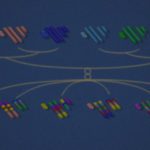Link to Pubmed [PMID] – 1378508
J. Virol. 1992 Aug; 66(8): 4698-704
Theiler’s murine encephalomyelitis virus is responsible for a chronic inflammatory demyelinating disease of the central nervous system of the mouse. The disease is associated with persistent viral infection of the spinal cord. Some strains of mice are susceptible to viral infection, and other strains are resistant. The effect of the genetic background of the host on viral persistence has not been thoroughly investigated. We studied the amount of viral RNA in the spinal cords of 17 inbred strains of mice and their F1 crosses with the SJL/J strain and observed a large degree of variability among strains. The pattern of viral persistence among mouse strains could be explained by the interaction of two loci. One locus is localized in the H-2D region of the major histocompatibility complex, whereas the other locus is outside this complex and is not linked to the Tcrb locus on chromosome 6.

